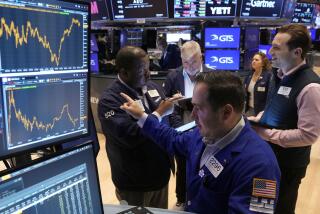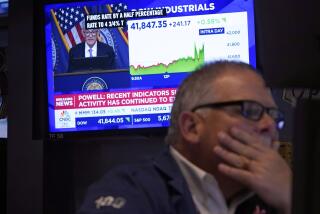FINANCIAL MARKETS : Bond Yields Surge as Dollar Slumps; Dow Slides 25.29 : Wall Street: U.S. currency sparks turmoil as world central banks decline to arrest steep selloff after recent sharp rise. Investors also sense that interest rates may not fall further.
Bond yields soared Thursday as a plunging dollar and signs of rebounding manufacturing activity shattered optimism that the Federal Reserve Board will cut interest rates again this year.
On Wall Street, stocks suffered broad losses in active trading but closed above their lows for the day. The Dow Jones industrial average fell 25.29 points to 4,767.40 after a nearly 50-point drop early in the day.
The dollar set the markets’ tone, as a steep selloff overnight in Tokyo continued unabated in New York, slashing the dollar’s value as low as 97 Japanese yen.
The dollar’s slump, after its sharp rally in recent months, was triggered by disappointment over Japan’s latest plan to rejuvenate its economy and by the Bank of Japan’s halfhearted defense of the U.S. currency when it began to weaken Thursday in Tokyo.
Many analysts wanted to see a Japanese economic recovery plan that encouraged more imports of foreign goods, which would send more yen abroad and potentially depress the currency’s value--a benefit to Japanese exporters.
Once the dollar’s slide began in Tokyo, it was exacerbated in Europe, after senior German government officials publicly questioned whether Italy could join the European Monetary Union--a psychological blow to weaker European currencies, which sent traders rushing into German marks at the dollar’s expense.
By day’s end in New York, the dollar was at 98.65 yen, down from 102.65 on Wednesday, and at 1.4205 marks, down from 1.4613.
What puzzled analysts was that major world central banks, which had vigorously defended the dollar in recent months, put up almost no resistance Thursday as bearish traders beat the dollar down.
“I’ve never quite seen such a confluence of events at the same time which have unnerved everybody,” said Steven Jury, chief currency dealer at Union Bank of Switzerland in New York.
By midday today in Tokyo, however, the dollar had risen above 100.50 yen, helped by renewed aggressive dollar buying on the part of the Bank of Japan.
In the U.S. bond market on Thursday, the dollar’s sudden slump was viewed negatively because a weak currency reduces the chances that the Fed can cut interest rates.
The odds of a rate cut appeared to grow even dimmer in the wake of a regional economic report from the Philadelphia Fed branch. That report showed a big jump in business activity this month.
Some traders also feared that Fed Chairman Alan Greenspan, in testimony he will give today on Capitol Hill, will paint a picture of an economy that doesn’t need additional rate cuts in order to grow.
By the end of trading Thursday, the 30-year Treasury bond yield stood at 6.56%, up from Wednesday’s 19-month low of 6.46% but below the afternoon high of 6.59%.
Shorter-term yields also jumped, with the six-month Treasury bill yield at 5.53%, compared to 5.44% on Wednesday.
Bonds’ turmoil was made worse by another steep jump in key commodity prices, possibly signaling higher inflation. Grain and cotton prices rose as an expected heavy frost in the Midwest threatened crops.
Freezing temperatures are expected for most of the Corn Belt today and Saturday, with a hard freeze, defined as temperatures of less than 28 degrees Fahrenheit, likely in northern growing regions, according to a forecast this morning from Weather Services Corp. of Lexington, Mass.
“There is the potential for damage and traders are very nervous,” said Robert Lekberg, analyst at Goldenberg, Hehmeyer & Co.
November soybean futures jumped 9 cents to $6.6375 a bushel at the Chicago Board of Trade, the highest for an active contract since mid-1994.
Corn prices, already the highest since 1988, inched up.
But offsetting those commodity price gains was a steep decline in oil prices, on signs that world crude oil inventories may be set to rise. November crude oil futures fell 51 cents to $17.56 a barrel on the New York Mercantile Exchange.
In the stock market, the damage appeared relatively mild, despite the chaotic day in other markets. Still, losers swamped winners by 14 to 8 on the Big Board.
Among Thursday’s highlights:
* Interest-rate-sensitive stocks slumped as bond yields reversed. J.P. Morgan slid 1 3/8 to 76 5/8, Merrill Lynch lost 1 1/4 to 62 1/4 and Federal National Mortgage tumbled 3 1/2 to 102 1/8.
* Many industrial stocks, which have fallen out of favor in recent days on earnings worries, continued to retreat. Caterpillar fell 1 to 58 7/8, Cincinnati Milacron dove 1 5/8 to 29 3/4, DuPont sank 1 5/8 to 68 3/8 and Chrysler dropped 1 3/4 to 55 1/2.
* AT&T;, which soared Wednesday after announcing it will break into three parts, lost 1 1/8 to 62 5/8.
* On the plus side, investors swarmed into drug and food stocks. Those shares often become refuges in uncertain markets, as investors seek out companies with stable earnings growth prospects.
Johnson & Johnson leaped 2 1/8 to 73 3/4, Pfizer shot up 1 7/8 to 50 3/4, Kellogg gained 1 1/8 to 71 1/8 and CPC International rose 1 3/8 to 67 5/8.
Overseas, Tokyo’s Nikkei-225 index ended down 163.85 points at 18,034.79.
*
Market Roundup, D6
More to Read
Inside the business of entertainment
The Wide Shot brings you news, analysis and insights on everything from streaming wars to production — and what it all means for the future.
You may occasionally receive promotional content from the Los Angeles Times.










